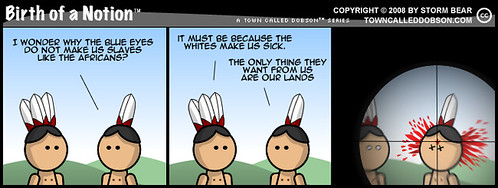 click to enlarge The first Native American group encountered by Christopher Columbus were the Island Arawaks (more properly called the Taino) of Boriquen (Puerto Rico), the (Quisqueya) of the Dominican Republic, and the Cubanacan (of Cuba). It has been said that of the 250,000 to one million Island Arawaks living in 1492, only about 500 had survived by the middle of the 16th century, and that the group was considered extinct by the middle of the 17th century. However, DNA studies show that the genetic contribution of the Taino to that region continues, and the mitochondrial DNA studies of the Taino are said to show relationships to the Northern Indigenous Nations, such as Inuit and others. European settlers brought infectious diseases against which the Native Americans had no natural immunity. Chicken pox and measles, though common and rarely fatal among Europeans, often proved deadly to Native Americans. Smallpox proved particularly deadly to Native American populations. Epidemics often immediately followed European exploration, sometimes destroying entire villages. While precise figures are difficult to arrive at, some historians estimate that up to 80% of some Native populations died due to European diseases. In 1617–1619, smallpox wiped out 90% of the Massachusetts Bay Native Americans. As it had done elsewhere, the virus wiped out entire population groups of Native Americans. It reached Mohawks in 1634, Lake Ontario in 1636, and the lands of the Iroquois by 1679. During the 1770s, smallpox killed at least 30% of the West Coast Native Americans. Smallpox epidemics in 1780–1782 and 1837–1838 brought devastation and drastic depopulation among the Plains Indians. By 1832, the federal government established a smallpox vaccination program for Native Americans (The Indian Vaccination Act of 1832). In the sixteenth century Spaniards and other Europeans brought horses to the Americas. Some of these animals escaped and began to breed and increase their numbers in the wild. Horses had previously migrated naturally to North America but the early American horse became game for the earliest humans and became extinct about 7,000 BC, just after the end of the last ice age. The re-introduction of the horse had a profound impact on Native American culture in the Great Plains of North America. As a new mode of travel the horse made it possible for some tribes to greatly expand their territories, exchange goods with neighboring tribes, and more easily capture game. During the 17th century, Indian slavery, the enslavement of Native Americans by European colonists, was common. Many of these Native slaves were exported to off-shore colonies, especially the "sugar islands" of the Caribbean. Historian Alan Gallay estimates that from 1670-1715, British slave traders sold between 24,000 and 51,000 Native Americans from what is now the southern part of the U.S. Slavery of Native Americans was organized in colonial and Mexican California through Franciscan missions, theoretically entitled to ten years of Native labor, but in practice maintaining them in perpetual servitude, until their charge was revoked in the mid-1830s. Following the 1847-1848 invasion by U.S. troops, Native Californians were enslaved in the new state from statehood in 1850 to 1867. Slavery required the posting of a bond by the slave holder and enslavement occurred through raids and a four-month servitude imposed as a punishment for Indian "vagrancy". The Haida and Tlingit Indians who lived along the Southeast Alaska's coast were traditionally known as fierce warriors and slave-traders, raiding as far as California. Slavery was hereditary, the slaves being prisoners of war. Among some Pacific Northwest tribes, about a quarter of the population were slaves. Other slave-owning tribes of North America were, for example, Comanche of Texas, Creek of Georgia, the fishing societies, such as the Yurok, that lived along the coast from what is now Alaska to California, the Pawnee, and Klamath. After 1800, the Cherokees and some other tribes started buying and using black slaves, a practice they continued after being relocated to Indian Territory in the 1830s. The nature of slavery in Cherokee society often mirrored that of white slave-owning society. The law barred intermarriage of Cherokees and blacks, whether slave or free. Blacks who aided slaves were punished with one hundred lashes on the back. In Cherokee society, blacks were barred from holding office, bearing arms, and owning property, and it was illegal to teach blacks to read and write. By contrast, the Seminoles welcomed into their nation African Americans who had escaped slavery (Black Seminoles). There were historical treaties between the European Colonists and the Native American tribes requesting the return of any runaway slaves. For example, in 1726, the British Governor of New York exacted a promise from the Iroquois to return all runaway slaves who had joined up with them. This same promise was extracted from the Huron Natives in 1764 and from the Delaware Natives in 1765. There are also numerous accounts of advertisements requesting the return of African Americans who had married Native Americans or who spoke a Native American language. Individuals in some tribes owned African slaves; however, other tribes incorporated African Americans, slave or freemen, into the tribe. This custom among the Seminoles was part of the reason for the Seminole Wars where the European Americans feared their slaves fleeing to the Natives. The Cherokee Freedmen and tribes such as the Lumbee in North Carolina include African American ancestors. After 1800, the Cherokees and some other tribes started buying and using black slaves, a practice they continued after being relocated to Indian Territory in the 1830s. The nature of slavery in Cherokee society often mirrored that of white slave-owning society. The law barred intermarriage of Cherokees and blacks, whether slave or free. Blacks who aided slaves were punished with one hundred lashes on the back. In Cherokee society, blacks were barred from holding office, bearing arms, and owning property, and it was illegal to teach blacks to read and write. Disclaimer:
BIRTH OF A NOTION WALLPAPER is now available for your computer. Click here. |
Monday, April 14, 2008
Black History: The Native Americans
Subscribe to:
Post Comments (Atom)








0 comments:
Post a Comment